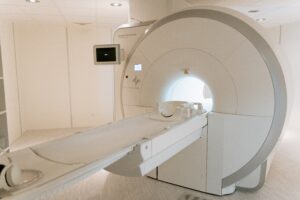Radiation- A history
Henri Becquerel discovered the non-visible waves emitted by Uranium, but it was his student Marie Curie who named it radioactivity. Marie Curie, Pierre Curie, and Henri Becquerel worked together to discover various uses of radioactivity, especially within the medical field. It was Marie Curie who invented the portable X-ray machine. Marie Curie eventually died due to her high exposure to radioactive materials. To learn more about the history and the effects of all forms of radiation, see the links below:
Types of Radiation-Ionizing and Nonionizing
Ionizing Radiation has enough energy to break off electrons from atoms and produce ions in matter at the molecular level; it can be very harmful to humans and can damage DNA. whereas Non-ionizing radiation has less energy, and while it can still injure humans, it mostly causes thermal damage.
Sources of Ionizing Radiation
Medical radiological procedures:
- X-rays
- Computed tomography (CT) scans
- Fluoroscopy, a medical diagnostic test that shows moving parts, often used in cardiovascular procedures
Sources of gamma ray emissions:
- Nuclear power plants
- Radionucleotide research
- Military weapons testing
- Nuclear medicine procedures such as bone, thyroid and lung scans

Health Effects of Ionizing Radiation
When ionizing radiation interacts with cells it can damage cells and DNA. The effects of exposure to ionizing radiation can be very severe and potentially deadly. Ionizing radiation is a known carcinogen. Dosage, frequency of exposure, type of radiation, and parts of the body that are exposed are all determinants of what health effects could be experienced.
Acute health effects of radiation exposure:
- nausea
- vomitting
- skin redness and burns
- hair loss
- acute radiation syndrome
Studies on populations that have been exposed to high levels of radiation such as people treated with high doses of radiation for cancer and other issues, survivors of the atomic bomb, uranium miners, etc., have shown a significant cancer risk increase for doses above 100mSv. It is not clear whether small doses increase your cancer risk but it is important to be cautious.
The forms of radiation we are most exposed to daily are Solar Radiation and Radiofrequency Radiation.
Solar radiation is a form of electromagnetic radiation emitted by the sun. Many negative health effects can manifest as a result of sun exposure due to the UV radiation sunlight carries. Exposure to UV radiation can cause skin cancer, premature aging, and sunburn. It is important to regulate your sun exposure and wear sunscreen, as UV exposure accumulates over time and can gradually increase your risk of skin cancer. For more in-depth information on the effects of UVA and UVB click here.
Solar Radiation can also be harmful for your eyes. Sun exposure can lead to cataracts and other eye diseases. It is helpful to wear sunglasses that protect against UVA and UVB radiation.
Not all sunscreens are created equal!
Sunscreens may contain chemicals that may have negative impacts on health or are harmful to the environment. This website provides information on the best and safest sunscreens to wear next time you want to go catch some rays!

Radiofrequency radiation is another prevalent form of radiation that we are exposed to everyday. We receive radiofrequency radiation exposure through natural sources such as the sun and the Earth as well as through human-made sources such as Radio, Television, Bluetooth, Wi-Fi, Security scanners, etc. Low amounts of Radiofrequency Radiation, the amounts a typical person is exposed to, are not known to cause harm. Exposure to high amounts of Radiofrequency radiation can cause burns, body tissue damage, and possibly cancer. Studies are still being done to test the effects of RFR, and to test how much RFR we are exposed to with the increased use of cell phones and Bluetooth devices. To learn more about Radiofrequency radiation click here. Check out ANHE’s webinar on RFR to learn more!
